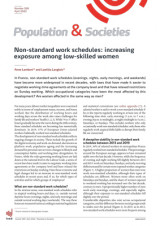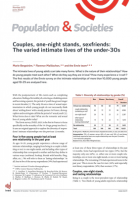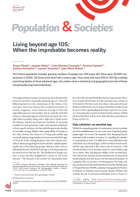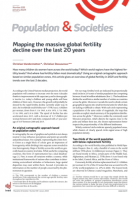
Non-standard work schedules: increasing exposure among low-skilled women
Population and Societies
n° 599, April 2022, 4 pages
https://doi.org/10.3917/popsoc.599.0001
French Institute for Demographic Studies
French Institute for Demographic Studies
Exposure to non-standard work schedules is far from marginal in France, and while the number of salaried workers concerned has not increased much over the last decade, the nature of exposure has shifted according to sex and social categories. Low-skilled women have been most affected by the development of non-standard work schedules, weekend working especially, while people in higher-level occupations have experienced a reduction in non-standard schedules, but also in unpredictable and variable work schedules.
Non-standard work schedules, night work, Sunday working, deregulation of working time, occupational categories, gender, Working Conditions survey, France
Table of contents
- Appendix A References
1.
In France, non-standard work schedules (evenings, nights, early mornings, and weekends) have become more widespread in recent decades, with laws that have made it easier to negotiate working-time agreements at the company level and that have relaxed restrictions on Sunday working. Which occupational categories have been the most affected by this development? Are women affected in the same way as men?
For many years, labour market inequalities were examined solely in terms of employment status, income, and hours worked. But the distribution of working hours and working days across the week also raises challenges for family life and workers’ health [1, 2, 3]. While ‘9-to-5’ office hours gradually became the norm during the 20th century, these standard schedules are becoming less numerically dominant. In 2019, 37% of European Union salaried workers habitually worked non-standard schedules.
The development of non-standard work schedules reflects ongoing changes in society. These include the growth of the digital economy and work-on-demand, also known as platform work; population ageing and the increasing demand for personal care services; changes in lifestyle and consumption habits; and working-time deregulation. In France, while the rules governing working hours are laid down at the national level in the Labour Code, a series of recent laws have made it easier to negotiate working-time agreements at the company level and have relaxed the restrictions on Sunday working. Have these economic and legal changes led to an increase in non-standard work schedules in recent years and, if so, for which types of activities and for which groups of employees?
1.1. What are non-standard work schedules?
In the strictest sense, non-standard work schedules refer to atypical working hours and days, i.e. outside normal daytime hours (evenings, nights, and early mornings) and outside normal working days (weekends). The way these hours are measured varies according to national regulations and statistical conventions (see online appendix [7]). A salaried worker is said to work a non-standard schedule if he or she reports regularly working in at least one of the following time slots: early morning (5 a.m. to 7 a.m.), evening (8 p.m. to midnight), at night (midnight to 5 a.m.), Saturdays, or Sundays. This excludes workers who only occasionally work non-standard schedules: only those who regularly work atypical shifts liable to disrupt their family life are concerned.
1.2. A deceptive stability in non-standard work schedules between 2013 and 2019
In 2019, 36% of salaried workers in metropolitan France regularly worked non-standard schedules. This percentage, around the European average, appears to have remained stable over the last decade. However, while the frequency of evening and night working fell slightly between 2013 and 2019, work on Saturdays, Sundays, and early morning shifts increased for certain more exposed worker categories (Figure 1). A higher proportion of women than men now work non-standard schedules, although their types of schedules are different. Women more often work on Saturdays and Sundays, and the share of women exposed to weekend working has increased over the last decade, contrary to men. A proportionally higher number of men work early mornings, evenings, and especially nights, although their exposure to non-standard schedules fell slightly over the period.
Considerable disparities also exist across occupational categories, and the difference between social groups tends to widen over the period (Figure 2). In 2019, as in 2013, non-standard work schedules were more frequent among low-skilled workers. In 2019, 1 in 6 employees in higher-level occupations regularly worked non-standard schedules compared with half of all manual workers and more than half of all unskilled employees, the most exposed category. Within this group, 4 in 10 salaried workers habitually work on Saturdays and one-quarter on Sundays. But between 2013 and 2019, exposure to non-standard work schedules fell by 18% among employees in higher-level occupations while remaining unchanged or increasing for the other occupational categories. For people in higher-level occupations, the type of job (more often amenable to working from home) and the type of employment contract (permanent contract) may have made it easier to implement company-level policies favouring work–life balance, as long promoted by the European Union [4].
We then consider occupational category by sex to take account of gender segregation in the labour market. Women’s exposure to non-standard schedules has decreased in the last decade for the most qualified women but has increased for the least qualified. For women in higher-level occupations, the share with non-standard schedules fell by 23% between 2013 and 2019 while increasing by 11% for female unskilled manual workers, the category with the largest recorded increase. For men, the social polarization of working hours is less pronounced. The share of men in higher-level occupations with non-standard work schedules fell by 14% between 2013 and 2019 while remaining unchanged for unskilled manual workers.
The association between non-standard work schedules and sex varies across occupational categories and sectors of activity, as confirmed by a logistic regression model (see online appendix [7]). While non-manual workers are more likely, on average, to work non-standard schedules than people in higher-level occupations, being a woman in this category reduces the risk of exposure. These women more often occupy qualified office jobs than their male counterparts who are over-represented in the fire brigade, police, armed forces, and security sector, where non-standard schedules are frequent. Likewise, unskilled manual workers are more likely to work non-standard schedules than people in higher-level occupations, although in this case, being a woman increases the risk of exposure. Many female unskilled manual workers work as cleaners, while men in this category are more often construction workers with more frequent daytime and weekday work schedules.
1.3. Multiple time constraints for the least qualified
Non-standard work schedules may also combine with other types of time constraints [5]. These include irregular hours (varying from one day to the next), split shifts (work periods separated by at least 3 hours), and unpredictable working hours (with notice of 24 hours or less) liable to affect workers’ well-being and family life [6]. Workers with a habitual non-standard work schedule are more often affected by these constraints than those with standard work schedules. In 2019, 35% of salaried workers with non-standard schedules also had variable schedules (compared with 24% of other salaried workers), 12% did not know their working hours in advance (compared with 8% of other workers), and 9% worked split shifts (compared with 3% of other workers).
The proportion of workers with non-standard work schedules concerned by these other types of time constraints varies by sex and occupational category (Table 1 and Figure 3). At the bottom of the social scale, unskilled manual and non-manual workers more frequently have split shifts and unpredictable schedules than workers in other categories, with women affected to the same extent as men, or more so; women in this category are among the most exposed. Conversely, highly qualified women (higher-level occupations and, to a lesser extent, intermediate occupations and skilled non-manual workers) appear less exposed to these constraints and less so than men in the same categories.
Moreover, as is the case for non-standard work schedules, these time constraints have tended to diminish for the most highly qualified workers over the last decade, for women especially. Changes have been more contrasting for the less qualified (Figure 3). Among people in higher-level occupations with non-standard schedules, the share of women exposed to unpredictable schedules and split shifts fell by 58% and 49%, respectively, between 2013 and 2019. This was the sharpest decrease observed. By contrast, female unskilled non-manual workers are increasingly exposed to unpredictable work schedules (+18%), while female unskilled manual workers with non-standard schedules have fewer split shifts but no reduction in unpredictable schedules.
1.4. Different working time regimes
A multiple correspondence analysis to capture the various combinations of time constraints identifies four groups of salaried workers (see online appendix [7]). The first, which includes 58% of the total, corresponds to people with ‘standard or marginally non-standard work schedules’. Most work between 35 and 39 daytime hours per week, although 1 in 10 also habitually works on Saturdays. Moreover, 83% work the same hours every day (compared with 60% of all salaried workers), so they know their work schedule well in advance. People in higher-level occupations are over-represented in this group, as are skilled clerical workers (corporate administrative employees and secretaries especially); 49% have a post-secondary qualification (vs. 44% of all salaried workers), reflecting the protective role of qualifications in exposure to time constraints.
The other three groups include people with different types of non-standard work schedules, which vary according to their frequency and the way they combine with the other time constraints. In the second group, that of ‘overworking and working hours extending into the evening’, which includes 12% of all salaried workers, 2 in 5 work for more than 44 hours per week, a proportion 3 times higher than for all salaried workers, and almost a quarter work between 40 and 44 hours per week compared with 1 in 6 of all salaried workers. Half of them often or always work beyond their official number of hours (vs. a quarter of salaried workers on average) and report working hours that vary from one day to the next. Last, non-standard schedules are occasional and mainly worked in the evening. Within this group, predominately made up of men in mid-career (ages 40–49), higher-level occupations are over-represented, as are public-sector workers (27% vs. 23% of all salaried workers).
The third group, which corresponds to ‘short hours, split shifts, and unpredictable schedules’, includes 18% of salaried workers, a majority of whom are low-skilled women. Almost half of the people in this group work fewer than 35 hours per week (compared with one-fifth of all salaried workers) and 1 in 4 works split shifts (vs. 5% of all salaried workers). Weekend working is most frequent in this group (64% habitually work on Saturday and 2 in 5 on Sunday, 3 times more than among all salaried workers), often with evening, early morning, or night shifts. The majority also have variable, non-modifiable, and unpredictable work schedules. Unpredictability is most frequent in this group, with 1 in 8 workers not knowing their work schedule from one day to the next. Women (65% of the total), young people aged 15–29, and the least qualified are over-represented in this group (half have a lower-secondary qualification or less). With more precarious employment contracts (22% are on fixed-term contracts vs 15% of all salaried workers), they work as unskilled non-manual workers (carers, domestic helpers, nursing auxiliaries), unskilled manual workers (cleaners), and as employees in the retail, transport, hotel, and catering sectors.
Last, the fourth group, that of ‘regular rotating shifts’, concerns 12% of salaried workers, many of whom are employed in manufacturing (men) and the health sector (women). This is the group with the highest proportion of night workers; 45% of people in this group work regular night shifts. A majority also work early mornings (80%), evenings (68%), and weekends (almost half). The high frequency of non-standard schedules in this group is linked to the need for 24-hour continuous output of a product or service: 55% have rotating shifts (vs. 8% of all salaried workers) and generally work in shifts around the clock. Skilled health workers account for a large share of the people in this group, alongside skilled manual workers in manufacturing. It also includes a large share of young people aged 15–39, as night working generally decreases with age.
***
Exposure to non-standard work schedules is far from marginal in France, and while the number of salaried workers concerned has not increased much over the last decade, the nature of exposure has shifted according to sex and social category. Low-skilled women have been most affected by the development of non-standard work schedules, weekend working especially, while people in higher-level occupations have experienced a reduction in non-standard work schedules, but also in unpredictable and variable work schedules.
The widening social disparities in non-standard work schedules, for women especially, appear to stem from a combination of two factors. On the one hand, work–family policies implemented by large corporations since the mid-2000s may have improved the working conditions of the most qualified workers, women especially, who also benefit from measures to foster gender equality in the workplace. On the other, low-skilled women are over-represented in the retail and distribution sectors where Sunday working has become more widespread (sales personnel, cleaners, or multitasking employees due to the automation of supermarket self-checkouts), and in the care and personal services sectors (nursing auxiliaries, carers, domestic helpers) where non-standard schedules are structural and have received significantly less attention.
1.4.1. Box 1. The DARES Working Conditions survey
Initiated in 1978, the Working Conditions survey (enquête Conditions de travail, see online appendix [7]), conducted by DARES (division for coordination of research and statistics), is the main source of data on work organization and working hours in France. To describe exposure to non-standard work schedules, we used the ‘individuals’ module of the 2013 and 2019 Working Conditions surveys which ask identical questions about the organization of working time and can be used to make comparisons over time.
Appendix A References
-
[1] Presser H. B., 2003, Working in a 24/7 economy: Challenges for American families, Russell Sage Foundation.
-
[2] Boulin J.‑Y., Lesnard L., 2016, Travail dominical, usages du temps et vie sociale et familiale: une analyse à partir de l’enquête Emploi du temps, Économie & Statistique, 486–487, 149–182.
-
[3] Täht K., Mills M., 2016, Out of time: The consequences of non-standard employment schedules for family cohesion, Springer.
-
[4] Brochard D., Blond-Hanten C., Robert F., 2015, Les effets de l’invitation européenne à agir sur la conciliation emploi-famille: une analyse comparée de la négociation collective en France et au Luxembourg, La Revue de l’Ires, 85–86, 99–143.
-
[5] Létroublon C., Daniel C., 2018, Le travail en horaires atypiques: quels salariés pour quelle organisation du temps de travail? DARES analyses, 30, June.
-
[6] Bèque M., 2019, Conciliation difficile entre vie familiale et vie professionnelle. Quels sont les salariés les plus concernés? DARES analyses, 45, September.
-
[7] Lambert A., Langlois L., 2022, Appendix on sources and illustrations, https://doi.org/10.34847/nkl.efafyj01.
Exposure to non-standard work schedules is far from marginal in France, and while the number of salaried workers concerned has not increased much over the last decade, the nature of exposure has shifted according to sex and social categories. Low-skilled women have been most affected by the development of non-standard work schedules, weekend working especially, while people in higher-level occupations have experienced a reduction in non-standard schedules, but also in unpredictable and variable work schedules.
Anne Lambert
Laetitia Langlois
Cite the article
Anne Lambert, Laetitia Langlois, Non-standard work schedules: increasing exposure among low-skilled women, 2022, Population and Societies, no. 599
 This document may be reproduced free of charge on paper or online using our Creative Commons licence.
This document may be reproduced free of charge on paper or online using our Creative Commons licence.








